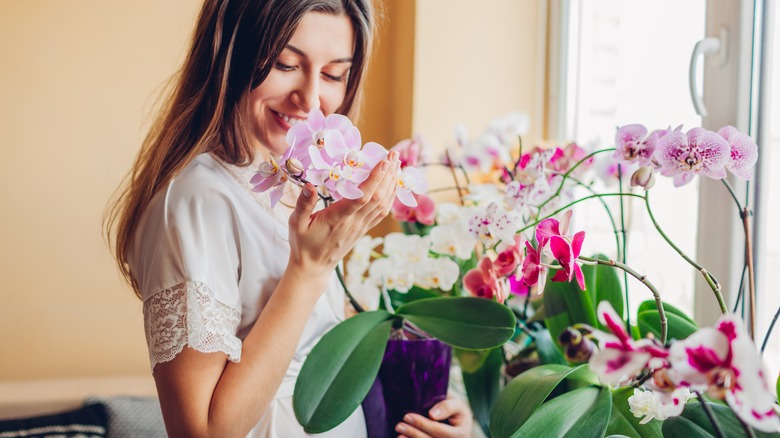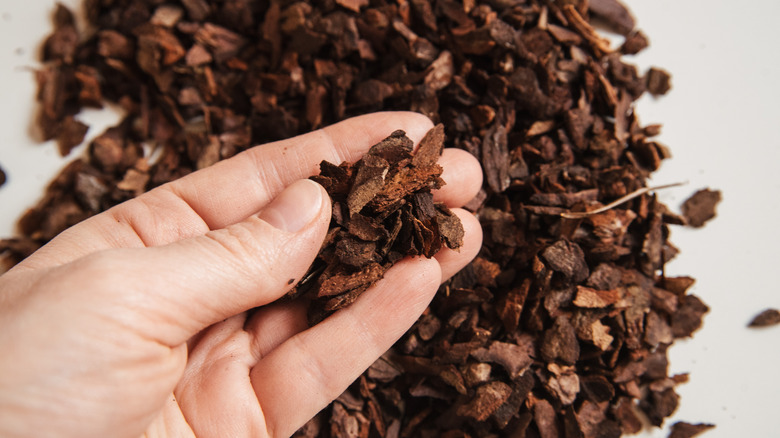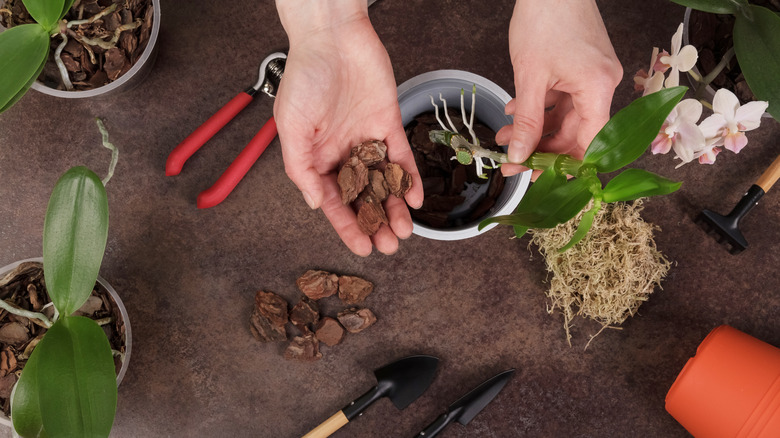The Best Thing You Can Do For Your Orchid's Long-Term Health
We may receive a commission on purchases made from links.
As a plant family, orchids do not like getting their feet wet. Some may prefer a high-humidity environment, but that doesn't mean they want their roots soaking in water all day, every day. This is even more the case for the many epiphytic species of orchid. What your orchid grows in — the pot and the substrate — has as much of an effect on how much water the plant is exposed to as how often you water it. Pine bark, sometimes conflated with fir or orchid bark, is the potting medium of choice for many orchid enthusiasts, amateur or expert. It holds water, but not too much, and drains well, among other benefits.
In nature, most orchids live life on the edge — that is, high up in trees (or more specifically, clinging to the bark), on rocky cliff-face outcrops, and atop crumbly, gravely dunes. They have root systems adapted to gripping precarious places and taking nutrients and moisture from the air. Pine bark mimics these environments, providing lots of uneven surfaces for orchid roots to wind around. With a pH of 3.4 to 4.8, it's also decently acidic, which many orchids prefer. Once, American redwood bark (Sequoia) was the go-to method for propagating orchids. However, due to a combination of resource depletion and the fact that redwood bark dust is a potential allergen, according to British wood supplier Wooduchoose, it has been replaced with other barks, most popularly pine bark.
Why orchids favor pine bark
As the name implies, pine bark consists of varying-sized pieces cut from the bark of Pinus radiata, grown predominantly in New Zealand. The bark is lighter in color than other orchid barks, and the pieces are less uniform in shape and size. It comes in three grades — fine (under 1/4 inch in size), medium (1/4 to 1 inch in size), and coarse (over 1 inch in size) — and each is suited to different types of orchids. Fine and medium-grade pine bark is helpful for baby plants, orchids that like more water, and those with small root systems. Larger orchids need a coarse bark. Pine bark is reasonably long-lasting; you can expect to change it only once every 2 to 3 years. This is when most orchids need repotting anyway.
For hobby orchidists, this substrate is cheap, sustainable (it's a waste product of the lumber processing industry), and easy to find almost anywhere. To ensure you're getting a quality product, look for bags with solid, dustless, and relevantly uniform bark chips. Amazon has 4 quarts of O-FarFarm Orchid Bark (Pine) in large size for $16.99. You can find New Zealand-sourced organic pine bark at Walmart; they stock a 2-quart bag of medium chips for $14.99. You can also shop at specialty nurseries, though you often have to commit to larger volumes. Georgia-based Orchid Supply Store has 2 cubic feet of Western fir and pine bark mix (extra small chunks) for $63.99 delivered.
Buying and using pine bark
You have your pine bark; it's time to replant an orchid or three. First, wash the bark thoroughly to remove any dust — this holds too much water. Add a layer of pine bark to the bottom of your planter. Give it a good shake or gently bang it on the table to ensure all the bark pieces fit together securely. Loose bark won't provide your orchid with the stability it needs. Add your orchid into the planter, then tuck handfuls of bark around the root system until it's full, shaking the pot as you go. You can use pine bark by itself. In particularly dry climates or if you're repotting a moisture-loving orchid variety, mix it with sphagnum moss.
Though it may seem that way, pine bark isn't infallible. It comes with a few ... product warnings. Some pine bark has a lot of resin and tannins, which can harm the roots of your orchid or even kill the plant. Also, some orchid experts say bark holds too much water, resulting in plant tissue-damaging rot. As the bark decomposes, it consumes a lot of nitrogen. Feed orchids planted in bark with a high-nitrogen fertilizer to counter this. After all, you want to make your orchid bloom again year after year!


